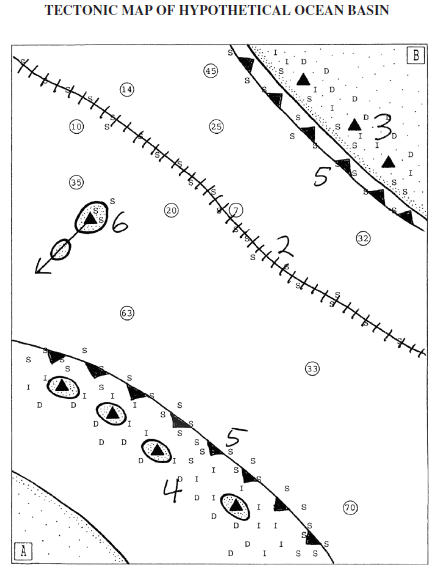What evidence shown on the map indicates that this type of boundary is present?
After drawing in the plate boundaries using the appropriate symbols on the tectonic map below, answer the question above. When asked to cite evidence to support your answers, only cite evidence that you can see on this map.

Scale: 1 cm = 300 km 11 inch = 500 miles2
Age of ocean floor increases away from band of shallow earthquakes.
You might also like to view...
The genuine progress indicator, or GPI, takes into account the harmful environmental and social costs of all transactions
Indicate whether the statement is true or false
For observers in the Norther Hemisphere, which of the following is true?
A) Day length is longest on the summer solstice and is shortest on the winter solstice. B) Day length decreases from the winter solstice until the vernal equinox, then it begins to increase. C) Day length is most pronounced on the equinoxes and least variable on the solstices. D) Day length becomes increasingly longer during the period from the summer solstice until the winter solstice. E) Day length variations are negligible for all locations throughout the year except north the Arctic Circle.
The surface temperatures of a metal plate, piece of wood, and piece of plastic were measured with an infrared thermometer. Air line above 20°C. Which object's surface recorded the lowest temperature?
A. plastic B. all measured the same C. wood D. metal plate
Which of the following describes changes in forest cover in Costa Rica since 1940?
A) Costa Rica has been regaining lost forest land since 1940, when strict forest regulations were passed and the country began serious reforestation efforts. B) Costa Rica has lost virtually all of its forests to agriculture since 1940. C) Costa Rica rapidly lost forests from 1940 until the 1980s, but its forests have more than doubled in size since then. D) Costa Rica's forests have changed dramatically in composition since 1940 because the forests have been invaded by European buckthorn and other invasive species. E) Costa Rica's forests increased in size slightly from 1940 until 1985, after which Costa Rica began rapidly losing forests because multinational coffee companies began cutting down rainforest to create coffee plantations.